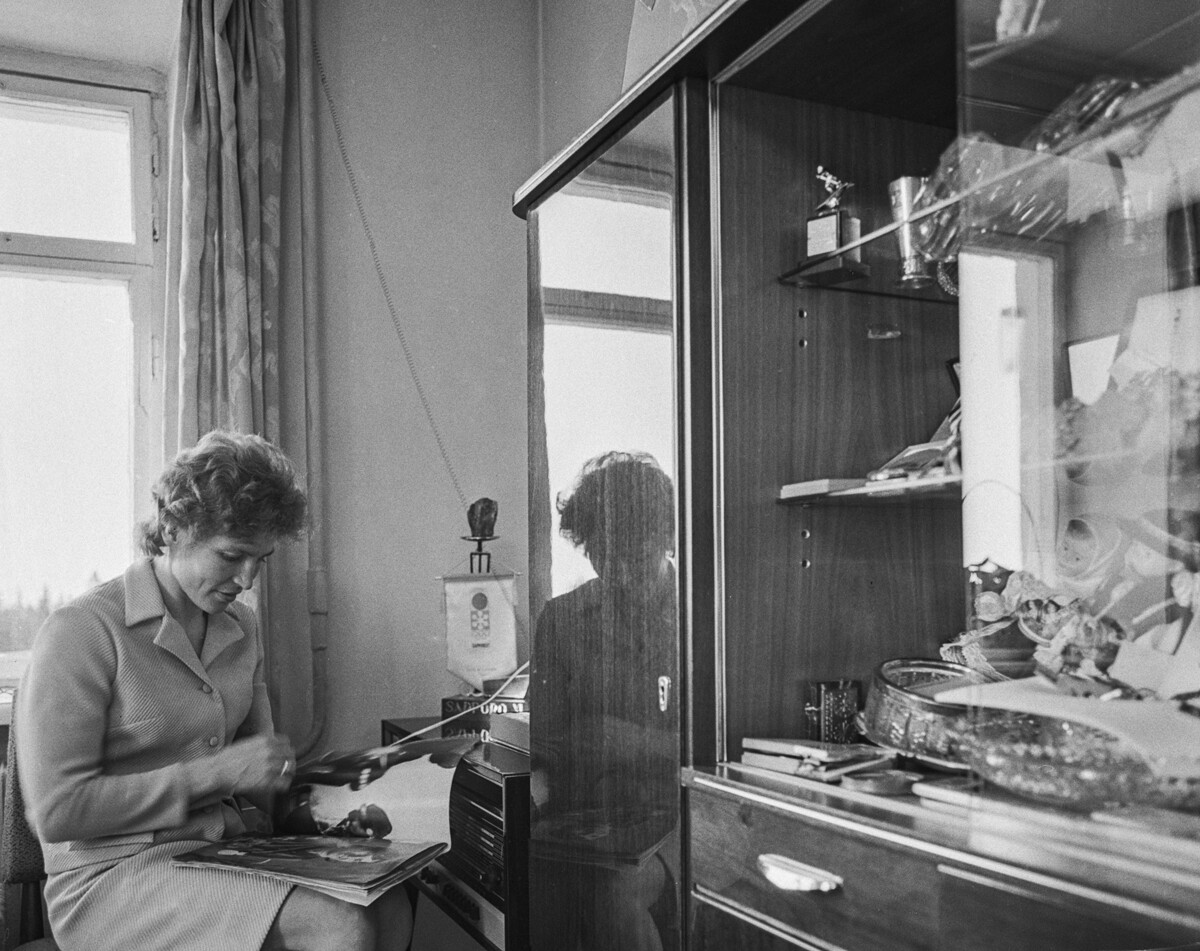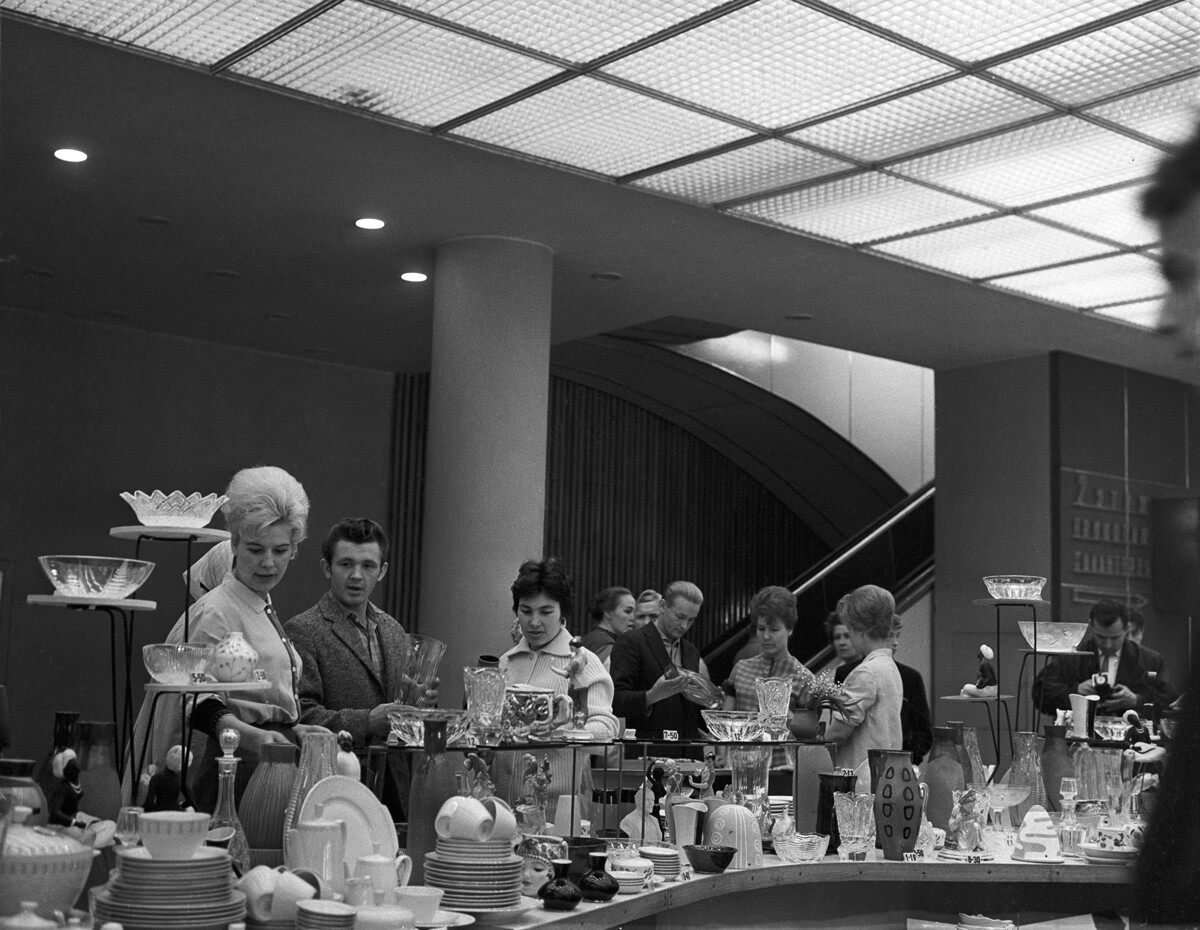A showcase of Soviet life: What the famous closets nicknamed ‘walls’ stored

Porcelain
Every Soviet housewife had a porcelain tea set. However, it was only used on special occasions - when guests were invited to the house for big family or nationwide celebrations. It was considered luxurious to have a set from the Lomonosov Porcelain Factory (LFZ) that was painted with a cobalt grid. This design, which has become one of the trademarks of St. Petersburg, was created in 1944 according to a sketch of the artist Anna Yatskhevich for the 200th anniversary of the plant and went into serial production in 1950.
 Moscow family, 1953
Moscow family, 1953
There are two versions of how this pattern came to be. According to the official version, the grid resembles that of the “Personal” tea set of the Empress Elizaveta Petrovna, under whom the porcelain manufacture (the predecessor of the porcelain factory) was founded. According to the second, “unofficial” version, the drawing is a metaphor for the cross-stitched house windows in the besieged Leningrad. Yatskiewicz was a survivor of the siege, lost her mother and sister in those years and, thus, wanted to perpetuate their memory. The artist was awarded a gold medal at the World Exhibition in Brussels in 1958 for her creation of the cobalt grid.
 Soviet tea set with "Cobalt netting" painting from Lomonosov Porcelain Factory (LFZ)
Soviet tea set with "Cobalt netting" painting from Lomonosov Porcelain Factory (LFZ)
Along with the cobalt netting, another object of public desire was the scarce ‘Madonna’ tea set from East Germany (GDR). The “bourgeois” look of porcelain with its mother-of-pearl, gilding and drawings of half-naked girls did not match the Soviet interior, but connoisseurs were not troubled by this fact.
“I remember my grandmother had these plates standing in the most visible part of the cupboard and they fascinated me. She took them out once a year, when the family gathered for her birthday and she prepared the table for tea. Now, I think that this pompous tableware in the living-room of a khrushchyovka apartment, though very cozy, with low ceilings and Soviet furniture from the 1980s, looked a little strange. But, for my mother, the ‘Madonna’ remnants are a memory from her mother, and for me they are a memory of my childhood and the friendly gatherings of my relatives, many of whom are no longer around,” recalls Maria Afanasyeva, the owner of several tea sets from the Soviet period.
 Madonna tea set
Madonna tea set
Typically, the holiday tea set was presented as a gift to people at weddings, so it served not only to decorate the interior, but also as a reminder of important family dates.
Teacups, teapots, and sugar bowls were usually placed on the lowest shelf of the cupboard. These could be accompanied by unusual flattened mugs with curved nozzles: burettes, or mineral water drinkers. Soviet citizens used to bring them from balneotherapy resorts.
 Moscow apartment, 1987
Moscow apartment, 1987
In the 1950s, medical tourism in the USSR became a mass phenomenon. There were almost no families in the country who would not spend a vacation “on the waters”. Sanatoriums located in the North Caucasus were considered to be the main health resort. The Kislovodsk porcelain factory produced special mugs for vacationers allowing them to drink mineral water without inhaling the smell of hydrogen sulfide and without exposing their teeth to minerals that destroy enamel. The year of manufacture was often inscribed on the burettes and the cup was also a reminder of a vacation in the south.
Crystal glassware
 Soviet skier and Olympic champion Galina Kulakova in her Izhevsk apartment, 1972
Soviet skier and Olympic champion Galina Kulakova in her Izhevsk apartment, 1972
Both layered holiday salads, such as herring under a fur coat or mimosa and the simpler Olivier and vinaigrette, as well as homemade pickles, required special serving. They were supposed to be served in heavy crystal salad bowls, which housewives also stored in their cupboards. They were usually placed on the second shelf. Gus-Khrustalny glassworks factory in the town of Gusev was the most popular manufacturer for this type of glassware. Heavy crystal vases were often presented as gifts on important occasions - for anniversaries, retirement parties and, on March 8. That is why almost every Soviet home had an entire collection of them.
 Family feast, 1950s
Family feast, 1950s
“Dressed herring is great when served in a crystal vase. My father was a truck driver and we had a lot of crystal glassware, especially from Gus-Khrustalny. It is nicer to drink from a crystal glass. And I like the vases very much – I have kept practically all of them,” a forum participant writes in a thread about nostalgia for the Soviet Union.
While the “heavy” crystal glassware was mostly Soviet-made, it was respectable to own foreign glasses, goblets and shot glasses. The presence of Czechoslovakian Bohemian crystal glassware at home was considered to be a sign of good taste and family wealth. It was more expensive than its Soviet equivalents.
 Celebrating feast at home, 1986
Celebrating feast at home, 1986
Cleaning the glassware was a special ritual. Several times during the year, or even more frequently, a Soviet housewife would take her treasures out of the cupboard to wash them in a vinegar solution. Thanks to this procedure, as well as to their infrequent use, the glassware always looked brand-new.
“Since I was a child, I was told that I couldn’t use the crystal dishes, because they were meant for a special day. However, all the dishes were taken out, washed and put back in again, two or three times a year. So, is it okay to take the crystal glass out of the cupboard or not?” one Internet forum user joked, posting a photo of his grandmother’s cupboard full of crystal glassware.
 Moskva store in Moscow, 1963
Moskva store in Moscow, 1963
“We used to get this crystal glassware out for every holiday. We would open the cupboard doors and pull out the GDR crystal tea set and immediately get us into a holiday mood, just like with a Christmas tree on New Year’s Eve,” the commentator replies.
Other artifacts
In addition to tableware, various memorabilia was kept in the cupboards in plain sight. These could be porcelain statuettes or figurines made of colored glass and matryoshka dolls. Often, one could see pictures of close relatives on the mirrored back wall of the cupboard: wartime photographs of parents, pictures of children and grandchildren in school uniforms (girls with bows and white aprons, boys with red pioneer ties). Sometimes, newspaper clippings were placed next to them, with materials about the labor exploits of family members or their workplaces.
 Natalia Chekhovskaya and Vasily Polushin, dancers of the Krasnoyarsk State Opera and Ballet Theater, at home, 1987
Natalia Chekhovskaya and Vasily Polushin, dancers of the Krasnoyarsk State Opera and Ballet Theater, at home, 1987
After the collapse of the USSR, the then young and “progressive” generation sought to get rid of the Soviet cupboards and their contents as obsolete junk. Thirty years later, interest in Soviet heritage is returning and, today, young people are looking for “grandma’s” tea sets and crystal glassware at flea markets. Designers are reproducing the retro-style in interiors, copying and restoring those very cupboards. On the one hand, this is a tribute to Soviet design, which often surpasses modern furniture and household items in its aesthetic and functional characteristics. On the other hand (and perhaps to a greater extent), it is a manifestation of nostalgia.
In 2018, a survey was conducted in Russia and 66% of the respondents admitted to having “a feeling of nostalgia towards the USSR”. Their share was the highest in the past decade. At the same time, the increase in sentiment was recorded in all age groups, including young people aged 18-24 - those who did live during the Soviet Union, but who may not have grown up among Soviet objects.
 Udelka flea market in St. Petersburg
Udelka flea market in St. Petersburg
“With Soviet objects, some want to recreate the atmosphere that prevailed during their childhood, their youth. They search for it, because it was present in their family, but, later, was lost, broken or stolen. To make up for the damage, they go to markets, surf websites. Some need a kettle lid, some need a spoon from a dinner set. Cups, plates, vases, figurines, jewelry and even photographs… Once I saw an adult standing and crying at the counter at the market, because, after a long search, he finally found something similar to his family relics,” says antiquarian Marina Veselova. “People need to surround themselves with things that bring back positive emotions.”

